Managing a consistent and effective social media presence in today's fast-paced digital world is more challenging than ever.
With the rapid evolution of trends, platform algorithms, and audience expectations, many businesses and creators struggle to stay organised, post regularly, and deliver engaging content.
Without a clear plan, it's easy to fall behind or miss valuable opportunities to connect with your audience.
That’s where a social media calendar becomes essential.
In this article, we’ll walk you through the steps to create a powerful social media calendar for 2025, helping you stay on track, streamline your workflow, and ensure your content strategy drives results.
Whether you're juggling multiple platforms or trying to keep up with the latest social media trends, this guide will equip you with practical tips and tools to plan, organise, and execute a winning social media strategy.
Table of Contents
- What is a social media calendar, and why do you need one?
- What are the benefits of a social media calendar?
- How to create a social media calendar in 5 steps
- Social media calendar template
What is a social media calendar, and why do you need one?
The social media calendar is a visual workflow that helps a social media team schedule their work daily, weekly, monthly, and even yearly.
In fact, this social media calendar should be the centrepiece of every successful social media strategy!
Why?
Because a social media calendar is the most effective way to organise content creation and curation processes across multiple social networks. It can also help determine the optimal publishing schedule that corresponds with marketing efforts on other channels.
It represents your very own road map to achieving all those KPIs with as little stress as possible.
A key benefit of having a social media content calendar is having a tool that helps me keep track of all content going out to different social channels, which helps me maintain consistency. It also reduces the everyday workload, allowing me to focus on other marketing tasks. Tricia Osazuwa, Marketing Executive at Virti
A handy social media management tool like Sendible can offer many more benefits, so let's explore them in the next section.
What are the benefits of a social media calendar?
1. It helps reduce everyday stress
Social media management is one of the most creative positions, but it comes with some stress. Developing a large amount of engaging content relevant to a particular niche is not easy!
This is where a predetermined schedule kicks in!
Consider creating a social media calendar instead of stressing out multiple times a week or month about creating social media posts that may or may not bring you closer to your KPIs. Once you've brainstormed the topics when your creative juices are at their highest, add them to a Google sheet or Asana calendar board, or schedule them for publishing or approval in a platform like Sendible!
2. It improves task distribution, workflow, and efficiency
Having a planned schedule of posts will also help you organise the workflow most efficiently.
Let's put this into practice.
According to the editorial calendar, four new blog posts are coming out next month. And you need to promote all of them on various social media platforms. With a social media calendar, you can easily:
- Plan out the publish dates
- Adjust copies to match social platforms' requirements
- Brainstorm different types of posts so you don't seem repetitive
- Add compelling visuals from Canva, Google Drive, Dropbox, or Content Library
- Give a heads-up and coordinate your efforts with the community manager
3. It takes post-personalisation to the next level
Publishing identical posts to different social media channels seems like an acceptable solution when you're out of time.
But, if a user is following you on all of your platforms, do you think they would be happy with seeing the same post pop out of every corner?
Planning helps you tailor the experience each social media post provides according to where the user sees it.
For example, a LinkedIn user expects different things from an Instagram one. While the first one might expect to see more data and business-related information, the second could look for interesting quotes and compelling videos.
4. It makes measurement, reporting, and optimisation easier
Having a plan means you have clear goals. And clear goals are easy to track and measure.
How will you measure success if you post inconsistently and without a clear direction? You'll never be sure why something worked or didn't.
Planning your social media content helps you align your efforts with business goals and other marketing activities. This omnichannel approach, in return, allows you to track the results of campaigns, optimise them, and pinpoint the most successful ones.
5. It helps maintain consistency
Worrying about how often you post won't get you closer to achieving the wanted results.
Consistency will.
Nothing is worse than getting your audience used to seeing five posts per week and then giving them the silent treatment for days.
This comes off as sloppy. In an oversaturated market, customers will easily convert to a different online community where they feel the brand cares for their needs.
The good thing is that you can automate the publication of evergreen content, such as:
6. It lowers repetition and improves diversity
You can kiss content fatigue goodbye if you have a social media calendar.
You'll likely become repetitive when you're in a tight race and have to produce lots of social media content under pressure.
You simply won't have time to:
- Perform a content audit
- Come up with fresh ideas
- Explore new content solutions
- Experiment with new formats and channels
A pre-planned and scheduled social media content calendar saves you loads of time! In return, you'll have more possibilities to do research, commit to social listening, and develop new ways to engage your audience.
7. It leaves extra time to prepare holiday campaigns
You cannot plan for some things, but holidays do not fall under this category.
Big holidays, such as Valentine's Day, Independence Day, Halloween, Thanksgiving, Christmas, and others, are great opportunities to reward your loyal fans and attract new ones.
To do so, you must plan social media campaigns in advance and set measurable goals to track results.
How to create a social media calendar in 5 steps
- Step 1: Revisit the client onboarding questionnaire
- Step 2: Set measurable goals
- Step 3: Decide which holidays, promotions, and engaging activities you'll cover
- Step 4: Choose the social media calendar tool
- Step 5: Plan the content calendar
Step 1: Revisit the client onboarding questionnaire
Before committing to creating a content plan for the upcoming period, you and your clients need to revisit the onboarding questionnaire. This will allow you both to get back on the same page, re-evaluate goals and objectives, and consider new content ideas and mediums.
You could use this occasion to look over the client's main call-to-action (CTA):
- Is it still relevant?
- Does it need to be updated?
- Or is a new one in order?
The opt-in allows your clients to build their email list and stay connected with their current and potential customers. Making sure this is something you can market and post about is essential.
If an opt-in isn't available or part of their strategy, review their website together to ensure that everything is working the way it should. You don't want to be sending users to dysfunctional landing pages!
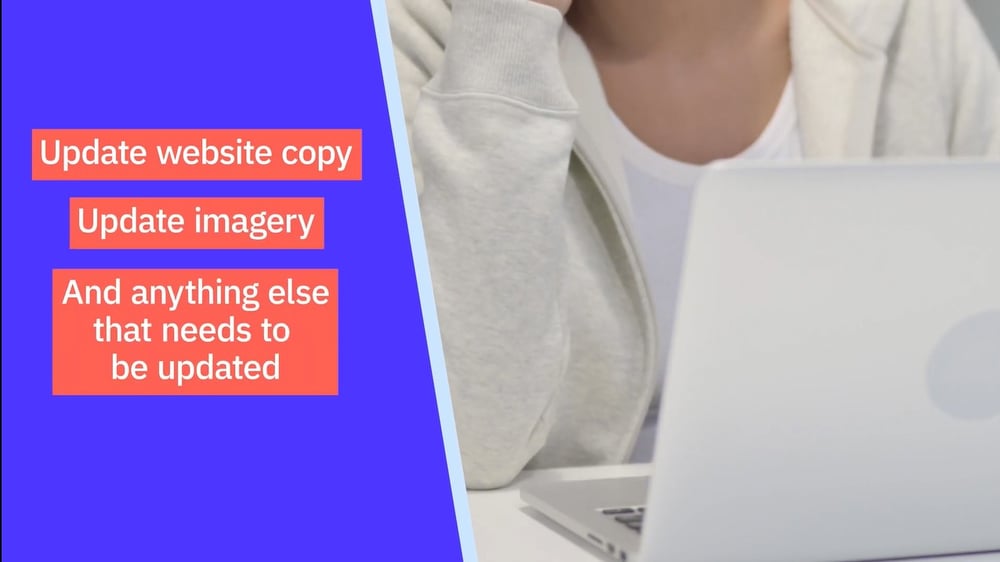
Another thing you should discuss with your client is their video strategy, as this format is the leading social media trend. This could require them to do some work, you two to collaborate, or for you to start creating for them.
Speaking of future planning, this would also be an excellent time to re-evaluate budgets and your offering. A bigger budget means more resources and more outstanding results for your client!
Step 2: Set measurable goals
The next thing on your list should be to set measurable goals for the upcoming period.
When getting started with this, you want to reflect on the previous year's numbers and sales:
- Was there growth?
- What posts and initiatives lead to sales?
- How high was the conversion rate?
- How many new leads did you get?
- And what about the overall engagement rate?
Going further, make sure to evaluate the performance of each social media account:
- How many new and returning visitors did each social platform provide?
- Which platform helped the most with brand awareness?
- What platform had the highest conversion rate?
- Which content format had the highest engagement?
Reviewing the past year will help you develop new solutions and optimisation opportunities and determine which social media channels are the best for your client's marketing goals.
According to these findings, you should also review platform commitments:
- What social media account should you focus on the most?
- Are there any new platforms you would like to test?
- Is there an opportunity to collaborate with other brands and influencers?
- Should you focus creative efforts on short-form videos or building a community with engaging content?
When making plans for the upcoming year, make sure to align them with the newest social media trends.
Once you are solid on the client's numbers, platforms, and objectives, you should set monthly and quarterly goals.
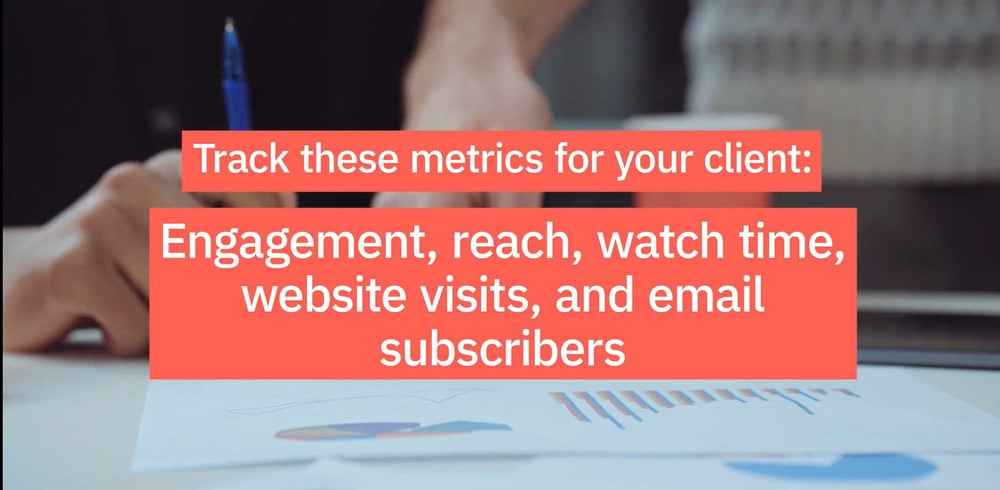
You can track these with a simple Google or Excel spreadsheet organised in a way that makes sense for you. You should also keep monthly and quarterly reports you get from your social media management tool (like Sendible) to enrich your findings and data.
Step 3: Decide which holidays, promotions, and engaging activities you'll cover
As we start heading into the planning phase of your social media calendar, you will want to outline important holidays, sales points, and initiatives that matter to the client.
You don't want your social media calendar to be all fluff and sales, though. So you must ensure that it is well-balanced and includes a proportionate number of fun holidays, promotions, deals, and valuable tips.
I always advise my clients to remember that it's called social media for a reason. You can't just directly sell and promote your products and services.
To truly connect with your audience, you must offer value. This valuable content can come in the form of advice, actionable tips, celebrating holidays, and sharing relatable stories or experiences. - Jana van Rensburg, Social Media Specialist
The holiday calendar is important for knowing what to post on which days. It wouldn't be a good look to post something promotional or salesy on a Day of Remembrance or encourage people to come into the client's business when they are closed for a bank holiday.
Take time to review local and world holiday calendars and mark them on your master calendar. These days will be a "rest" day or "engagement" day for content.
If you want to pepper your social media content with some fun topics, you can consider including themed days if they tie into the client's voice.
For example, National Bring Your Dog to Work Day could be good if one of your clients really loves their dog or dogs are allowed in their place of business. These opportunities will enable the client to show their more relatable, human side. You can also tie in trends like #TechTuesday or #ThrowbackThursday as a way to offset promotional content.
While holidays are essential for cultural and societal awareness, a sales calendar is vital for your customer's sales strategy. You need to know what sales and promotions they plan to run so you can post accordingly. Sometimes, sales align with holidays and seasons, and sometimes, they go hand in hand with industry trends and social patterns.
Most of us are familiar with over-the-top 4th of July sales in the United States, where retailers are looking to offload summer items in preparation for fall inventory, but this doesn't apply to most service-based businesses. Additionally, if your client runs an eCommerce business, Black Friday followed by Cyber Monday will likely be their time to shine.
Global holidays are lovely to participate in as a brand. But you need to be mindful that while all celebrate some holidays, that can happen at different times of the year in other countries.
For example, Mother's Day is celebrated on the second Sunday of May in the United States but in March in the United Kingdom. It is important to be aware of these differences for your clients depending on where they do most of their business. This way, they can participate accurately and be sensitive to the local needs and customs of the holiday.
When creating a content schedule for sales dates, make sure to review the previous year's sales numbers to see if any patterns could help maximise sales opportunities for your client.
Now that you have a firm grasp on the stable, unmovable things like holidays and sales, it's time to plan the fun stuff!
These can be trends you'd like to try, experiments with content types, or new mediums. You can also use this time to get customers involved by asking for customer reviews to share on social media and seeing what behind-the-scenes or team involvement you could include in the strategy. Just make sure that while it is fun, it's still aligned with the core objectives and goals of the customer.
Step 4: Choose the social media calendar tool
Before planning your social media calendar, you must decide which format and tools work best.
Option 1: Google Sheets
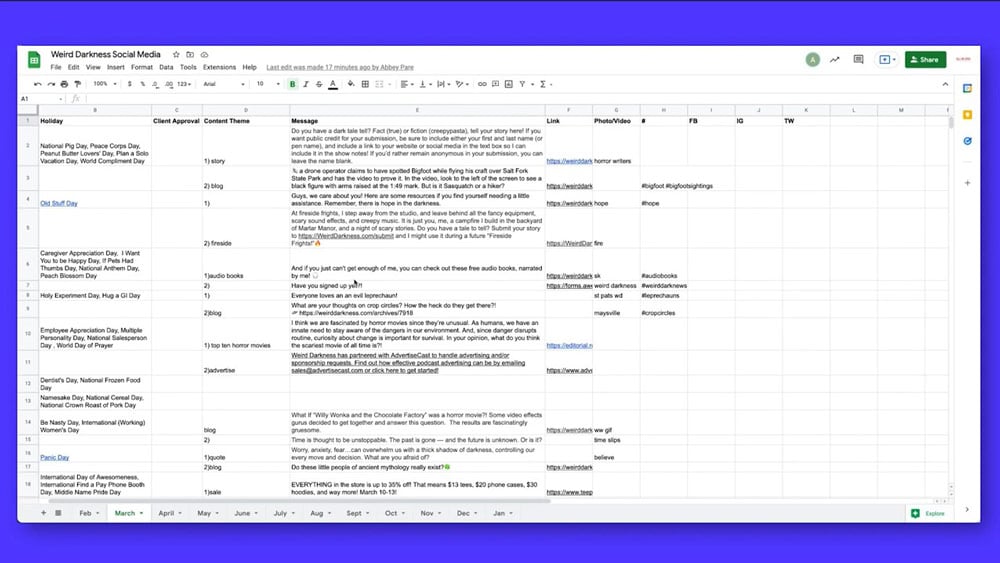
Google Sheets make it easy to collaborate as a team and with the client. Desiree Martinez likes to send a new spreadsheet with tabs for each month to her clients annually. Each tab includes:
- Date
- Holidays
- Client approval column,
- Content theme
- Messaging
- Any links that are shared, such as links to photos or videos
- Any unique or specific hashtags that her team needs to use for the posts
Option 2: Airtable
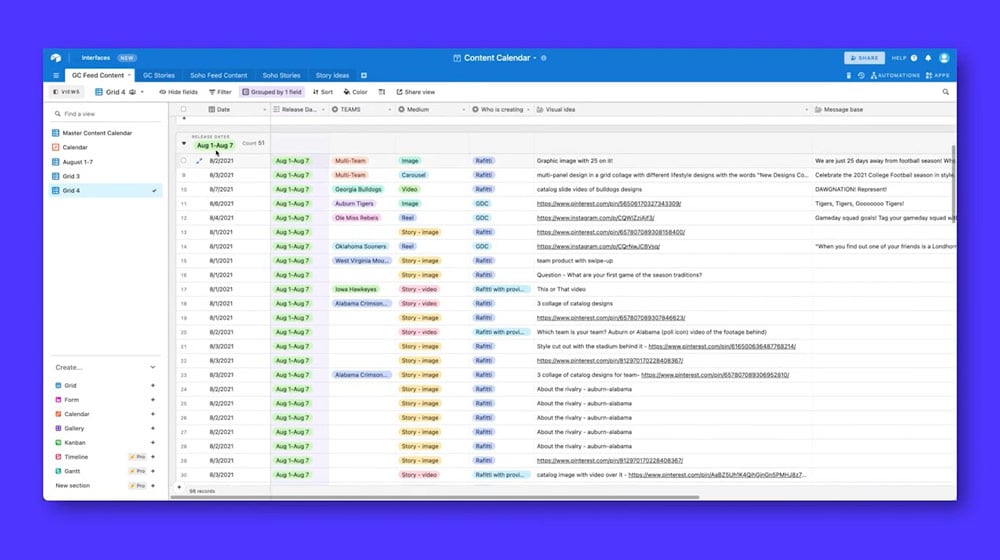
If you have a pervasive client with much content shared in different mediums on different platforms, a tool like Airtable could benefit you.
As you can see from the above example, there are separate tabs for the various brand media types. Since the company does many posts per week with multiple licensed brands, they state which licensed brand is being used for each post and what day the post is going out on. They also identify the medium type for the post, which team member is creating what, the ideas and inspiration for the visuals and the post, message base, internal notes, and where these posts will be published.
This tool can come in handy when you need to manage many platforms. Labelling things keeps everything organised, and the team can easily make changes and pivot.
Option 3: Asana
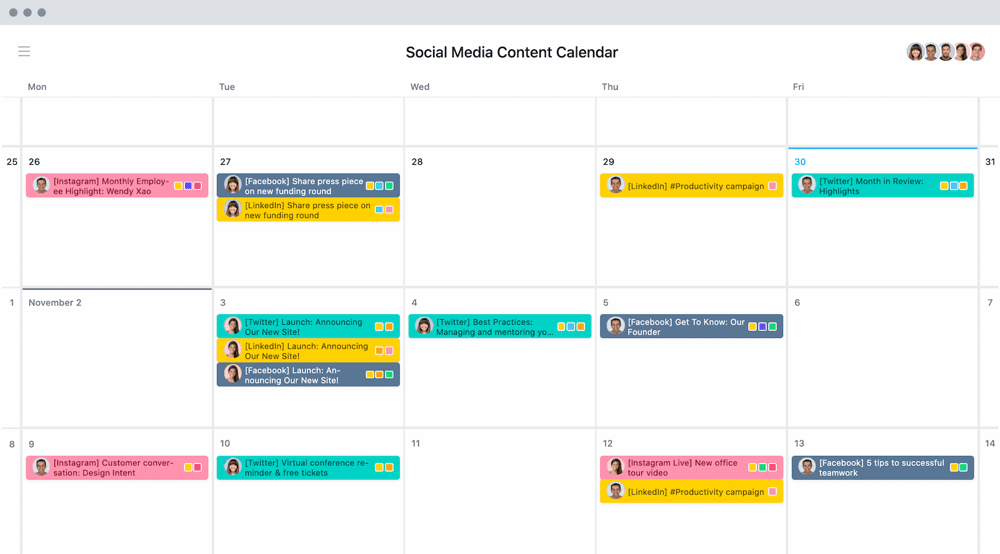
image source: Asana
If you have a big team and prefer to have everything in one place - the Asana calendar is the perfect solution for you.
You can:
- Assign a tag to each post to make it visually clear which platform you're creating it for
- Add subtasks for each team member
- Save all materials in one place, making it easy to repurpose or repost
Option 4: Social media management tool
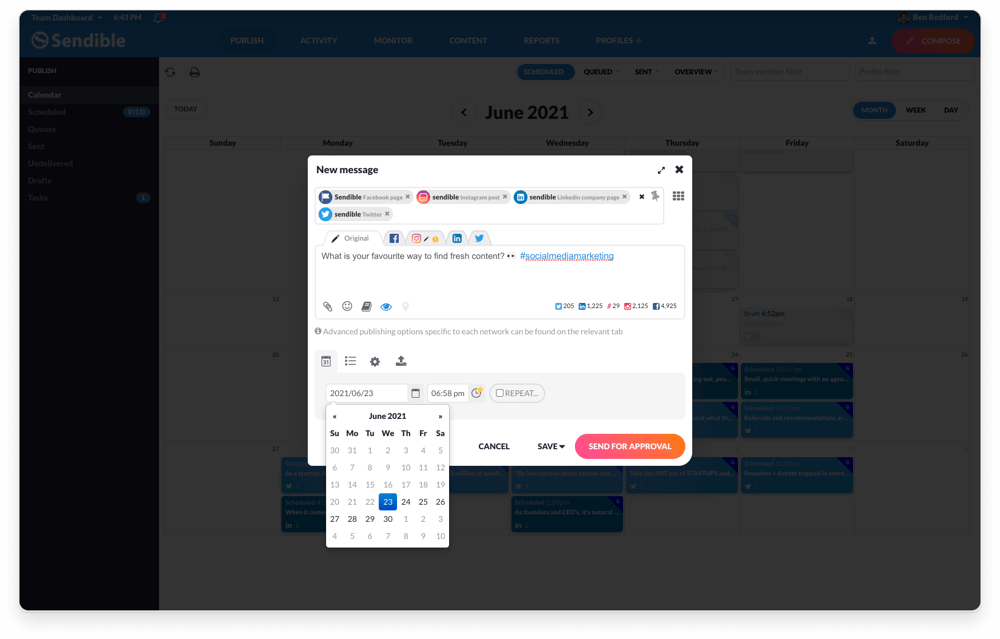
The most advanced option is to use a social media scheduling and management tool like Sendible.
Sendible's calendar allows you to:
- Plan and tailor each post for a different platform by using the simple centralised compose box.
- Assign it to various team members
- Import designed media directly from Canva (if you have a Pro account)
- Share it with your client for approval
- Schedule it for publishing.
This option helps you speed things up as you can create individual posts and batch them by theme and then schedule them all in one place.
Step 5: Plan the social media calendar
Once you know what method you will use to organise your content calendar, it is time to fill it in with your notes and dates.
You'll need to decide how often you're going to post on each of your chosen platforms. There's no right or wrong answer here. What's more important is publishing quality content on a consistent basis. It helps to establish your client’s goals first and then work backwards from there.
For example, if your client wants to get 10 contact enquiries from Facebook every month, you will spend more time creating exciting content on this network rather than pinning inspirational content on Pinterest.
Next, you'll need to consider your content mix. You need a balance of your client's content plus curated content from other reliable and relevant sources. And you'll need to decide what type of content you require for each network. Let's take a look at some of the inputs:
- What sales dates do you need to plan? For example, there are annual and seasonal sales like Black Friday, Cyber Monday, and Christmas that may be applicable.
- Does your client write their own blog post and if so, do you need to factor these in?
- Are they launching a new product or releasing a product update?
- Are there any company, local, or national events to add to the mix?

Once this is done, you can work month-to-month on the messaging and the other content to round out the social media calendar. This content can be changed quickly while also being mixed and matched.
These posts can be current industry news, engaging questions, tasteful humour, company stories about the service and products, staff highlights, office culture, and behind the scenes content.
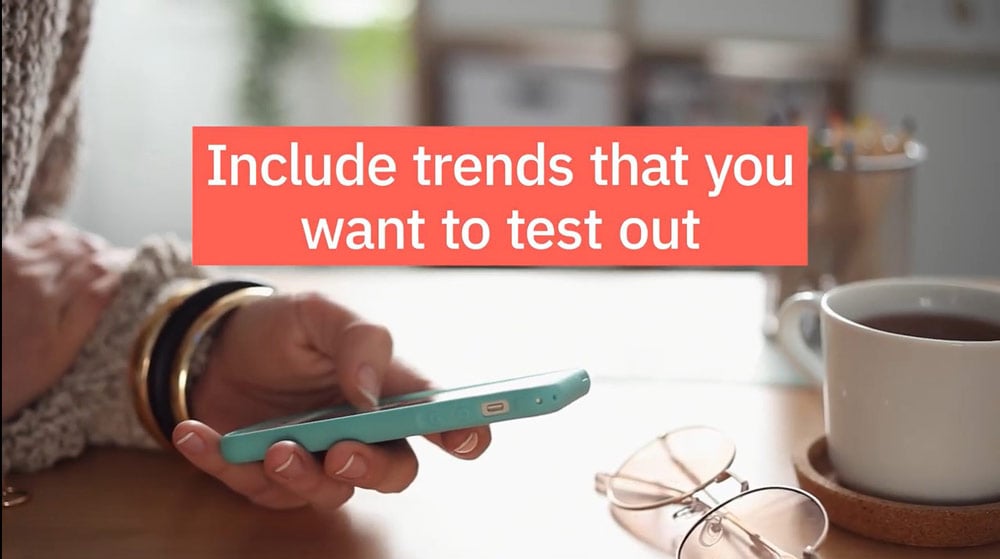
Planning is the most critical and time-consuming part. But it makes creativity and messaging easier! If you know what you are doing and the rhythm of the brand, your job will go so much smoother.
And Sendible's integration with GIPHY, Pexels, and Canva will make it even easier.
Social media calendar template
If you're not ready to plan with a social media management tool, you can use this free template.
| Date | Platform | Type | Pillar | Copy | Media | Hashtags | CTA | Status |
|---|---|---|---|---|---|---|---|---|
| 2024-09-12 | Image Post | New Product Launch | Page link | "Shop now" | Approved | |||
| 2024-09-15 | TikTok | Video Post | BTS | Video link | "Watch the video" | Needs Edits | ||
| 2024-09-20 | Tweet | Blog Post Promo | Blog link | "Read more" | Approved |











